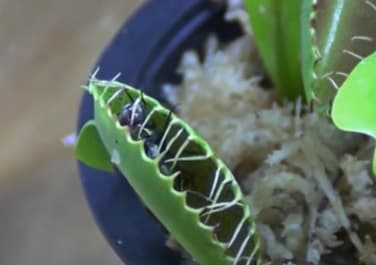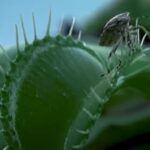As an Amazon Associate, this site earns commissions from qualifying purchases. For more details, click here.
Venus flytraps are both fascinating and scary. Watching its traps catch and eat a bug makes you wonder what happens if you touch it. Some might tell you never to lay finger on a Venus flytrap.
They are correct. You should avoid touching Venus flytraps, but not for the reason you might expect.
Touching a Venus flytrap is not going to harm you, but it can hurt the plant because closing its trap requires a lot of energy. If it doesn’t get nutrients after using its trap, the plant will weaken.
Can Venus Flytraps Bite You?
No they cannot. Its traps look menacing but they are harmless. Those sharp looking teeth are not teeth at all, and they aren’t that sharp.
The traps are meant to only catch and eat small bugs. Venus flytraps grow in poor soil and obtain their nutrients from insects.
So what happens if you put your finger in the trap?
The trap will attempt to close but it won’t hurt. You’re going to feel the trap but it won’t sting or cut you. Human fingers are too big for the trap so it won’t be able to close completely.
The most you will feel is a bit of pressure, but that’s it. You can pull your finger out anytime. And nothing bad will happen even if you leave your finger in there for several minutes.
Related. Can Venus Flytraps Hurt You?
What Happens If You Touch Venus Flytraps?
While touching Venus flytraps is harmless to us humans, it is risky for the plant and could be fatal. Here’s why.
Like all carnivorous plants, Venus flytraps grow in poor soil. To compensate for the lack of nutrients, these plants developed traps to catch insects, which are the nearest nutrition sources available.
These traps require a lot of resources to open and close. Digesting food also consumes much of the plant’s energy. Venus flytraps accept this trade-off because it gets nutrients in return.
This is why you should not put your finger in a Venus flytrap. It is harmless to you, but the trap will attempt to close anyway. This is going to use most of the trap’s energy.
The traps can only close a few times before it withers and falls off. Venus flytraps can replace the trap with a new one thanks to the nutrients it has absorbed.
But if the trap uses its energy on your finger, it won’t be able to replace the used up energy. The trap expends all its resources trying to digest your finger (which it cannot do). Without any nutrients going in, the trap will weaken and possibly die.
If you want to keep your Venus flytrap healthy, don’t play with it. Plant it in the right soil (I suggest Leaves and Soil mix), provide at least 6 hours of sunlight and plenty of water.
This is one of the reasons why Venus flytraps have a reputation for being hard to keep alive,. Their requirements differ from regular plants, but caring is straightforward.
Will Venus Flytraps Eat Your Blood?
The short answer to this question is yes and no. Yes, Venus flytraps can and will eat (or drink) human blood. But it can’t do so unless you provide it.
Some people might tell you Venus flytraps won’t consume human blood. Insects don’t have any so why would Venus flytraps want ours?
But as this video shows, Venus flytraps will drink human blood. Why it does so isn’t clear but there’s no doubt it does.
Does blood provide nutrients for Venus flytraps? It’s possible. That could be why Venus flytraps will digest blood. And judging from these experiments, it doesn’t suffer any side effects.
But you don’t have to worry. Venus flytraps might like human blood, but it can’t cut you. If you watched the video, blood had to be supplied to the plant. It cannot cut your skin.
Are Venus Flytraps Poisonous?
Venus flytraps are not toxic to humans. You can touch the plant anywhere, anytime and it will not poison your skin.
Most Venus flytraps secrete enzymes, substances that can dissolve an insect and make it easier to digest.
These enzymes are lethal to bugs but not humans. it has a sticky feel but is harmless.
Of course it’s a different matter for insects. If a fly fell into the trap, its movements trigger the trap and it will close over the fly. The more the insect struggles, the tighter the trap gets.
This is when Venus flytraps release enzymes to dissolve its prey. This substance is harmless to us, but it is potent to insects..
Are Venus Flytraps Safe for Dogs and Cats?
Yes, dogs and cats are safe. Your cat can eat the leaves or traps and it won’t cause any harm.
The worst thing that can happen is your pet might suffer mild indigestion. But other than that it’s safe. Venus flytraps are actually the ones at risk from dogs and cats.
What about other animals? Any animal bigger than the trap is safe. Even cockroaches and beetles are mostly safe, except for those small enough to fall in the trap.
If you want to grow a Venus flytrap indoors, make sure it is safe from pets. Place the plant where pets cannot reach it, but there has to be sufficient light, water and humidity.

Dangers of Venus Flytraps Debunked
There are a lot of misconceptions about Venus flytraps. Most of them center on how dangerous it supposedly is. The following are some of the most widespread and the truth about them.
Myth 1: Venus flytraps can trap your finger and bite you.
Not true. The traps on a Venus flytrap are only a few inches long at most. Not large enough to trap your finger.
You can put your finger in it and there’s no danger. And in spite of its scary appearance, those traps cannot and do not bite.
Venus flytraps don’t even bite insects, their natural nutrient source. They trap the bugs and use enzymes to dissolve it. After digesting the prey, the trap opens, leaving the insect’s skeletal remains.
Myth 2: Venus flytraps eat anything
Venus flytraps can only eat flies, small spiders, grasshoppers and other small insects.
Venus flytraps cannot eat burgers, hotdogs, chocolates, fruits or vegetables. You can put those things in the trap and it won’t shut.
Even if you stimulate the trap to close, it can’t digest the food. The best case scenario is the food will remain untouched. Worst case is the trap tries to eat it.
The trap will not be able to process the food and die. So do not give your Venus flytrap anything other than bugs.
Myth 3: Venus flytraps eat human flesh
There is actually some truth to this. No, Venus flytraps cannot eat your finger, but experiments have shown that Venus flytraps can eat bits of flesh.
Just to be clear though. The experiment only involved bits of dead skin. It’s not as if the plant can eat your fingers.
Myth 4: Venus flytraps eat lots of insects
Venus flytraps are not voracious eaters. Most of them eat once every two weeks. Some only eat once a month.
Venus flytraps can produce 5 traps or more simultaneously, but only one trap (or two) eats at a time.
I’ve seen people force feed multiple traps and that’s not good for the plant. Venus flytraps allocate resources to eat. If you feed all the traps it will hurt or kill the plant.
A Venus flytrap doesn’t have enough nutrients to consume all the food. So feed one trap at a time.
If your Venus flytrap is outdoors it doesn’t have to be fed. If you see a trap closed, it means the plant is eating.
Myth 5: Venus flytraps don’t eat dead bugs
Venus flytraps can eat dead bugs but will need help from you.
Its traps are triggered by motion. If a live bug falls into the trap, its movement is going to set off the trap and it will snap shut. The plant releases enzymes to break the insect down and digest it.
If you put a dead bug in the trap, it won’t close because there’s no movement. Venus flytraps can’t distinguish between a dead prey and a rock.
You have to use a a paintbrush or tweezers to stimulate the trap and close. When it shuts the digestive process will commence.

My fascination with carnivorous plants began many, many years ago with Venus Fly Traps. Now I am more than happy to impart what I know with other enthusiasts and those who are curious about meat eating plants.


